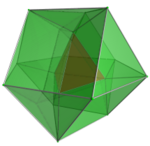قبة (هندسة)
| Set of cupolae | |
|---|---|
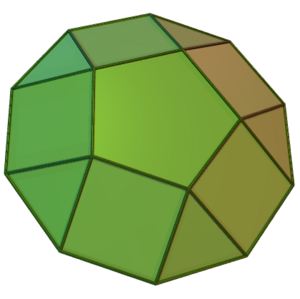 Pentagonal example | |
| الأوجه | n triangles, n squares, 1 n-gon, 1 2n-gon |
| الحواف | 5n |
| الرؤوس | 3n |
| رمز شلفلي | {n} || t{n} |
| Symmetry group | Cnv, [1,n], (*nn), order 2n |
| Rotation group | Cn, [1,n]+, (nn), order n |
| Dual polyhedron | ? |
| الخصائص | محدب، prismatoid |
In geometry, a cupola is a solid formed by joining two polygons, one (the base) with twice as many edges as the other, by an alternating band of isosceles triangles and rectangles. If the triangles are equilateral and the rectangles are squares, while the base and its opposite face are regular polygons, the triangular, square, and pentagonal cupolae all count among the Johnson solids, and can be formed by taking sections of the cuboctahedron, rhombicuboctahedron, and rhombicosidodecahedron, respectively.
A cupola can be seen as a prism where one of the polygons has been collapsed in half by merging alternate vertices.
A cupola can be given an extended Schläfli symbol {n} || t{n}, representing a regular polygon {n} joined by a parallel of its truncation, t{n} or {2n}.
Cupolae are a subclass of the prismatoids.
Its dual contains a shape that is sort of a weld between half of an n-sided trapezohedron and a 2n-sided pyramid.
. . . . . . . . . . . . . . . . . . . . . . . . . . . . . . . . . . . . . . . . . . . . . . . . . . . . . . . . . . . . . . . . . . . . . . . . . . . . . . . . . . . . . . . . . . . . . . . . . . . . . . . . . . . . . . . . . . . . . . . . . . . . . . . . . . . . . . . . . . . . . . . . . . . . . . . . . . . . . . . . . . . . . . . .
Examples
The above-mentioned three polyhedra are the only non-trivial convex cupolae with regular faces: The "hexagonal cupola" is a plane figure, and the triangular prism might be considered a "cupola" of degree 2 (the cupola of a line segment and a square). However, cupolae of higher-degree polygons may be constructed with irregular triangular and rectangular faces.
Coordinates of the vertices
The definition of the cupola does not require the base (or the side opposite the base, which can be called the top) to be a regular polygon, but it is convenient to consider the case where the cupola has its maximal symmetry, Cnv. In that case, the top is a regular n-gon, while the base is either a regular 2n-gon or a 2n-gon which has two different side lengths alternating and the same angles as a regular 2n-gon. It is convenient to fix the coordinate system so that the base lies in the xy-plane, with the top in a plane parallel to the xy-plane. The z-axis is the n-fold axis, and the mirror planes pass through the z-axis and bisect the sides of the base. They also either bisect the sides or the angles of the top polygon, or both. (If n is even, half of the mirror planes bisect the sides of the top polygon and half bisect the angles, while if n is odd, each mirror plane bisects one side and one angle of the top polygon.) The vertices of the base can be designated through while the vertices of the top polygon can be designated through With these conventions, the coordinates of the vertices can be written as:
where j = 1, 2, ..., n.
Since the polygons etc. are rectangles, this puts a constraint on the values of The distance is equal to
while the distance is equal to
These are to be equal, and if this common edge is denoted by s,
These values are to be inserted into the expressions for the coordinates of the vertices given earlier.
Star-cupolae
قالب:Star-cupolae قالب:Star-cupoloids Star cupolae exist for all bases {n/d} where 6/5 < n/d < 6 and d is odd. At the limits the cupolae collapse into plane figures: beyond the limits the triangles and squares can no longer span the distance between the two polygons (it can still be made if the triangles or squares are irregular.). When d is even, the bottom base {2n/d} becomes degenerate: we can form a cupoloid or semicupola by withdrawing this degenerate face and instead letting the triangles and squares connect to each other here. In particular, the tetrahemihexahedron may be seen as a {3/2}-cupoloid. The cupolae are all orientable, while the cupoloids are all nonorientable. When n/d > 2 in a cupoloid, the triangles and squares do not cover the entire base, and a small membrane is left in the base that simply covers empty space. Hence the {5/2} and {7/2} cupoloids pictured above have membranes (not filled in), while the {5/4} and {7/4} cupoloids pictured above do not.
The height h of an {n/d}-cupola or cupoloid is given by the formula
In the images above, the star cupolae have been given a consistent colour scheme to aid identifying their faces: the base {n/d}-gon is red, the base {2n/d}-gon is yellow, the squares are blue, and the triangles are green. The cupoloids have the base {n/d}-gon red, the squares yellow, and the triangles blue, as the other base has been withdrawn.
Anticupola
| Set of anticupolae | |
|---|---|
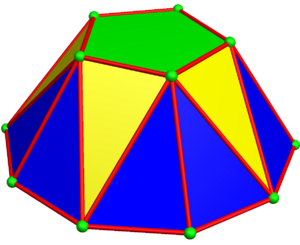 Pentagonal example | |
| الأوجه | 3n triangles, 1 n-gon, 1 2n-gon |
| الحواف | 6n |
| الرؤوس | 3n |
| رمز شلفلي | {n} || t{n} |
| Symmetry group | Cnv, [1,n], (*nn), order 2n |
| Rotation group | Cn, [1,n]+, (nn), order n |
| Dual polyhedron | ? |
| الخصائص | convex, prismatoid |
An n-gonal anticupola is constructed from a regular 2n-gonal base, 3n triangles as two types, and a regular n-gonal top. For n = 2, the top digon face is reduced to a single edge. The vertices of the top polygon are aligned with vertices in the lower polygon. The symmetry is Cnv, order 2n.
An anticupola can't be constructed with all regular faces, [بحاجة لمصدر] although some can be made regular. If the top n-gon and triangles are regular, the base 2n-gon can not be planar and regular. In such a case, n = 6 generates a regular hexagon and surrounding equilateral triangles of a snub hexagonal tiling, which can be closed into a zero volume polygon with the base a symmetric 12-gon shaped like a larger hexagon, having adjacent pairs of colinear edges.
Two anticupola can be augmented together on their base as a bianticupola.
| n | 2 | 3 | 4 | 5 | 6... |
|---|---|---|---|---|---|
| Name | s{2} || t{2} | s{3} || t{3} | s{4} || t{4} | s{5} || t{5} | s{6} || t{6} |
| Image |  Digonal |
 Triangular |
 Square |
 Pentagonal |
 Hexagonal |
| Transparent | 
|

|

|

|
|
| Net | 
|
. . . . . . . . . . . . . . . . . . . . . . . . . . . . . . . . . . . . . . . . . . . . . . . . . . . . . . . . . . . . . . . . . . . . . . . . . . . . . . . . . . . . . . . . . . . . . . . . . . . . . . . . . . . . . . . . . . . . . . . . . . . . . . . . . . . . . . . . . . . . . . . . . . . . . . . . . . . . . . . . . . . . . . . .
Hypercupolae
The hypercupolae or polyhedral cupolae are a family of convex nonuniform polychora (here four-dimensional figures), analogous to the cupolas. Each one's bases are a Platonic solid and its expansion.[3]
See also
. . . . . . . . . . . . . . . . . . . . . . . . . . . . . . . . . . . . . . . . . . . . . . . . . . . . . . . . . . . . . . . . . . . . . . . . . . . . . . . . . . . . . . . . . . . . . . . . . . . . . . . . . . . . . . . . . . . . . . . . . . . . . . . . . . . . . . . . . . . . . . . . . . . . . . . . . . . . . . . . . . . . . . . .
References
- ^ "cupolas". www.orchidpalms.com. Retrieved 21 April 2018.
- ^ "semicupolas". www.orchidpalms.com. Retrieved 21 April 2018.
- ^ أ ب Convex Segmentochora Dr. Richard Klitzing, Symmetry: Culture and Science, Vol. 11, Nos. 1-4, 139-181, 2000
- Johnson, N.W. Convex Polyhedra with Regular Faces. Can. J. Math. 18, 169–200, 1966.
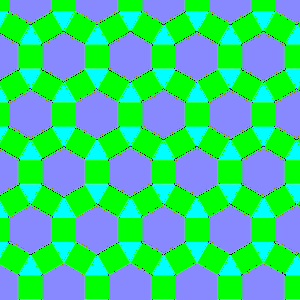
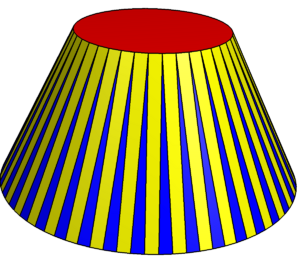




![{\displaystyle {\begin{array}{rllcc}V_{2j-1}:&{\biggl (}r_{b}\cos \left({\frac {2\pi (j-1)}{n}}+\alpha \right),&r_{b}\sin \left({\frac {2\pi (j-1)}{n}}+\alpha \right),&0{\biggr )}\\[2pt]V_{2j}:&{\biggl (}r_{b}\cos \left({\frac {2\pi j}{n}}-\alpha \right),&r_{b}\sin \left({\frac {2\pi j}{n}}-\alpha \right),&0{\biggr )}\\[2pt]V_{2n+j}:&{\biggl (}r_{t}\cos {\frac {\pi j}{n}},&r_{t}\sin {\frac {\pi j}{n}},&h{\biggr )}\end{array}}}](https://www.marefa.org/api/rest_v1/media/math/render/svg/9115be8c669d2bcc7ed3166bd318fbcd1f464061)



![{\displaystyle {\begin{aligned}&r_{b}{\sqrt {\left[\cos \left({\tfrac {2\pi }{n}}-\alpha \right)-\cos \alpha \right]^{2}+\left[\sin \left({\tfrac {2\pi }{n}}-\alpha \right)-\sin \alpha \right]^{2}}}\\=\ &r_{b}{\sqrt {\left[\cos ^{2}\left({\tfrac {2\pi }{n}}-\alpha \right)-2\cos \left({\tfrac {2pi}{n}}-\alpha \right)\cos \alpha +\cos ^{2}\alpha \right]+\left[\sin ^{2}\left({\tfrac {2\pi }{n}}-\alpha \right)-2\sin \left({\tfrac {2\pi }{n}}-\alpha \right)\sin \alpha +\sin ^{2}\alpha \right]}}\\=\ &r_{b}{\sqrt {2\left[1-\cos \left({\tfrac {2\pi }{n}}-\alpha \right)\cos \alpha -\sin \left({\tfrac {2\pi }{n}}-\alpha \right)\sin \alpha \right]}}\\=\ &r_{b}{\sqrt {2\left[1-\cos \left({\tfrac {2\pi }{n}}-2\alpha \right)\right]}}\end{aligned}}}](https://www.marefa.org/api/rest_v1/media/math/render/svg/a72756b659b558d0aea4a2461d713884a2dc1bf9)

![{\displaystyle {\begin{aligned}&r_{t}{\sqrt {\left[\cos {\tfrac {\pi }{n}}-1\right]^{2}+\sin ^{2}{\tfrac {\pi }{n}}}}\\=\ &r_{t}{\sqrt {\left[\cos ^{2}{\tfrac {\pi }{n}}-2\cos {\tfrac {\pi }{n}}+1\right]+\sin ^{2}{\tfrac {\pi }{n}}}}\\=\ &r_{t}{\sqrt {2\left[1-\cos {\tfrac {\pi }{n}}\right]}}\end{aligned}}}](https://www.marefa.org/api/rest_v1/media/math/render/svg/fd71b0f8638a6a9418944879c1ad1e40cdaa10d1)
![{\displaystyle {\begin{aligned}r_{b}&={\frac {s}{\sqrt {2\left[1-\cos \left({\tfrac {2\pi }{n}}-2\alpha \right)\right]}}}\\[4pt]r_{t}&={\frac {s}{\sqrt {2\left[1-\cos {\tfrac {\pi }{n}}\right]}}}\end{aligned}}}](https://www.marefa.org/api/rest_v1/media/math/render/svg/708562f3c88c7adfcd25bf632d98106c0abe8e62)





